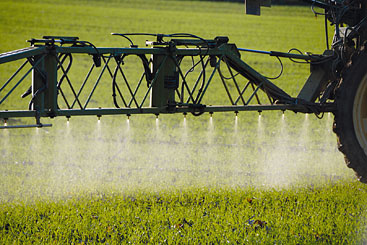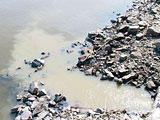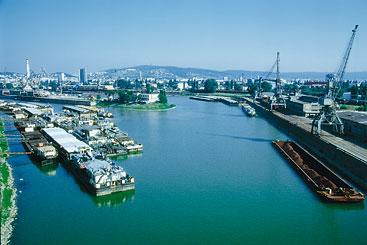
Defining the future of the Danube River Basin
Based on the results of the Danube Basin Analysis, the ICPDR has defined four significant water management issues that will help guide the work in the basin towards the Danube River Basin Management Plan.

To achieve the ICPDR‘s vision for organic and nutrient pollution, countries will need to phase out – by 2015 at the latest – all discharges of untreated wastewater from all agricultural installations and apply best environmental practices.
Countries cooperating under the Danube River Protection Convention, including those outside the European Union, have agreed to implement the EU Water Framework Directive (WDF) throughout the Danube River Basin. The first step of the WDF process was completed in 2004 by finalising the ‘Danube River Basin Analysis’, or Roof Report, and was the first comprehensive study of the basin’s transboundary surface and groundwaters.
The Roof Report helped identify four significant water management issues in the Danube Basin District for surface waters: pollution by organic substances, nutrients and hazardous substances, and alterations to hydromorphology (such as the structural characteristics of the shape, natural morphology and boundaries of rivers and lakes, and transitional and coastal waters), and two transboundary groundwater issues including alterations to quality and quantity.
“It’s extremely important that now for the first time at the river basin scale the main issues have been agreed upon,” says Marieke Van Nood, part of the Water Framework Directive Team at the European Commission, and Co-chairperson of the ICPDR’s River Basin Management Expert Group. “Since the Danube is such a large river basin, this is special that this happened on such a large scale and that the document goes further and looks at how to address these issues.”
Zero emission of untreated wastewaters. The
ICPDR’s basin-wide vision for organic pollution
is zero emission of untreated wastewaters into the
waters of the Danube River Basin. For EU member
states this means phasing out all discharges of untreated
wastewater from towns with populations over
10,000 as well as implementing the Urban Wastewater
Treatment Directive. In other Danube countries
this will mean specifying wastewater collecting systems
and wastewater treatment plants planned to be
constructed by 2015, as well as specifying treatment
levels and emission reduction targets.

Removing the threat of eutrophication. Balanced management of nutrient emissions is the vision for nutrient pollution, to ensure that the waters of the Danube River Basin and the Black Sea are not threatened by eutrophication. To achieve this, all countries will need to reduce the nutrient discharges entering the Danube and its tributaries; reduce nutrient discharges to the Black Sea to levels that permit those ecosystems to recover to conditions observed in the 1960s; reduce phosphates in detergents; and implement best agricultural practices. In addition, EU member states will need to implement the EU Nitrates Directive.
No risk to human health or aquatic ecosystems. The
ICPDR’s vision for hazardous pollution is to ensure
that human health and the aquatic ecosystem of the
waters of the Danube River Basin and those of the
Black Sea are not threatened by hazardous substances.
For all Danube countries, achieving this vision means
eliminating the discharges of hazardous substances
entering the Danube and its tributaries; improving
treatment efficiency, and setting up quantitative reduction
objectives for pesticide emissions. In addition,
EU member states will implement the Integrated Pollution
and Prevention Control Directive, which also
relates to the Dangerous Substances Directive.
Providing a holistic home for all species. Balancing the management of past, ongoing and future structural changes of the surface water environment is the ICPDR’s vision to make certain that ecosystems in the Danube River Basin function holistically and are home to all native species. This will mean ensuring migratory species are able to access the Danube and its tributaries, reconnecting and restoring floodplains and wetlands and ensuring that future infrastructure projects follow best environmental practices and best available techniques so that negative transboundary effects are fully prevented, mitigated or compensated.
Protecting groundwater quality and quantity. To meet the ICPDR’s vision that groundwater quality is not deteriorated by pollution emissions, and to restore quality in areas that are already polluted, all countries will need to eliminate the hazardous substances and nitrates entering groundwater and increase the efficiency of wastewater treatment. EU member states will also have to implement a number of EU directives on groundwater, nitrates, plant protection, biocides, wastewater and pollution prevention. Furthermore, the ICPDR aims to ensure that water use is appropriately balanced and does not exceed the available resources by implementing sound groundwater management to avoid over-extraction.

The ICPDR‘s vision for surface water is that hazardous substances pose no risk to human health or aquatic systems and that, by balancing management of structural changes, the aquatic ecosystems function holistically and provide habitats for all native species.
Timeline and public participation. Completing the Danube River Basin Management Plan will require full public participation and consultation, including providing all relevant documents for public review and comment. National data for the Plan and the Joint Programme of Measures will be collected until the end of this year and public consultation at the international level will run until the end of June 2009. The comments will be analysed and integrated into the final management plan where feasible. The Danube River Basin Management Plan, including the Joint Programme of Measures, will be finally endorsed by the Danube Ministers in 2010.
The visions and management objectives for the significant water management issues guide the Danube countries towards achieving the objectives of the WFD. “These issues will help guide not only the countries themselves but also the work of the ICPDR”, says Van Nood, “and the international coordination of the river basin management plans.”
The ‘Significant Water Management Issues in the Danube River Basin District’ (full text and summary) can be found on the ICPDR website: www.icpdr.org/river-basin-management.
Disclaimer
The information contained in the ICPDR website is intended to enhance public access to information about the ICPDR and the Danube River. The information is correct to the best of the knowledge of the ICPDR Secretariat. If errors are brought to our attention we will try to correct them.
The ICPDR, expert group members, nor other parties involved in preparation of information contained on this website cannot, however, be held responsible for the correctness and validity of the data and information provided, nor accept responsibility or liability for damages or losses arising directly or indirectly from the use of the information conveyed therein.
Only those documents clearly marked ICPDR documents reflect the position of the ICPDR.
Any links to other websites are provided for your convenience only. The ICPDR does not accept any responsibility for the accuracy, availability, or appropriateness to the user's purposes, of any information or services on any other website.
When using the information and material provided on this website, credit should be given to the ICPDR.
